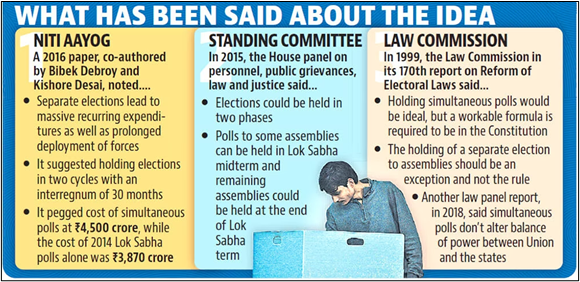PREVIOUS
Simultaneous Elections in India
September 24 , 2024
388 days
1055
0
- The Union Cabinet has ‘unanimously’ approved the Kovind panel's report on simultaneous polls.
- The Committee recommended a series of constitutional amendments to facilitate simultaneous elections at the central, state, and local levels.
- The One Nation, One Election project hinges on two Constitution Amendment Bills being passed by Parliament.
- The first Constitution Amendment Bill to transition to a simultaneous election system will require a ‘special majority’ of both the Lok Sabha and Rajya Sabha.
- The second Constitution Amendment Bill will ensure that all local body elections (for municipalities and panchayats) are held within 100 days of the simultaneous elections.
- For this, the amendment shall also require to be ratified (agreed to) by the Legislatures of not less than one-half of the States in the country.
- This is because “local government” is a subject under the State List in the Seventh Schedule, which means only states have the power to pass laws on this subject.
- The scheme proposed by the Kovind Committee, if a state Assembly or Lok Sabha is dissolved before the end of its ‘full’ five-year term, a ‘mid-term’ election will take place.
- But, the newly elected state Assembly or Lok Sabha will only serve for the remaining period before the next simultaneous elections are scheduled to take place.
- This period between a mid-term election and a scheduled simultaneous election will be known as the “unexpired term”.
- During India's first four general elections (1951-52, 1957, 1962, 1967), the electorate voted for their respective state assemblies as well.
- Later, the process was ended due to formation of new states and reorganisation of others.
- In 1968-89, some legislative (state) assemblies were dissolved and led to ONOE being discontinued completely.

Leave a Reply
Your Comment is awaiting moderation.


